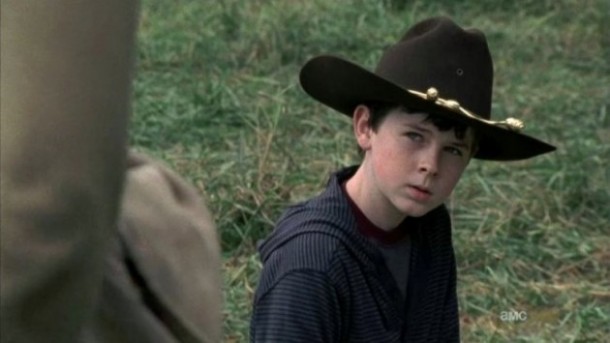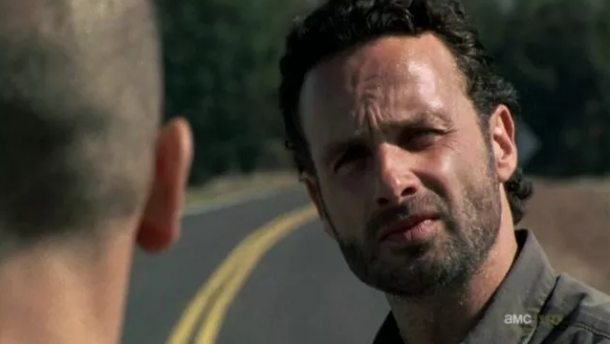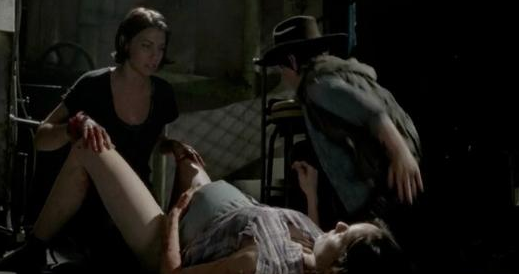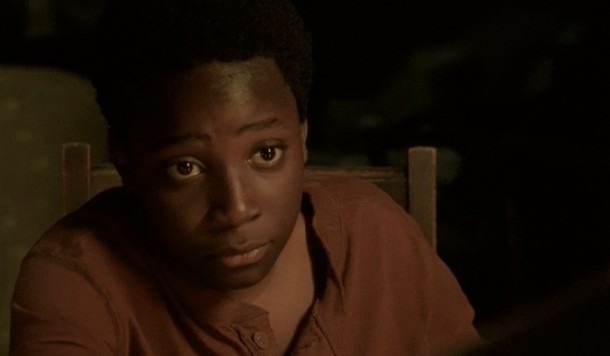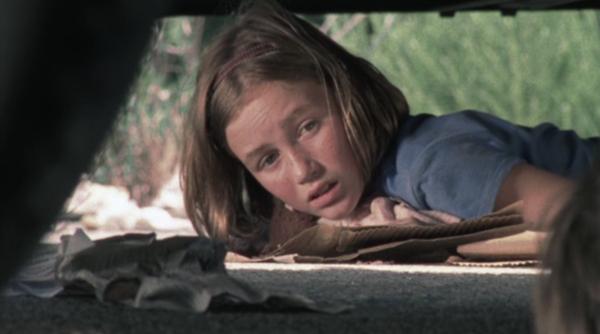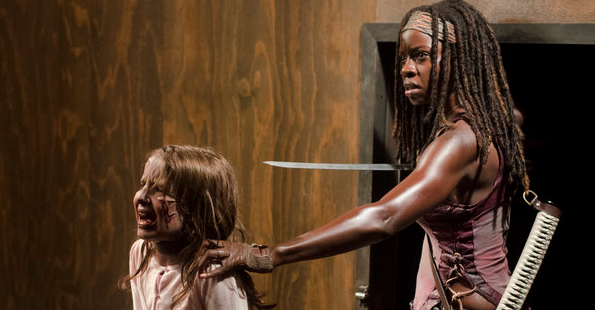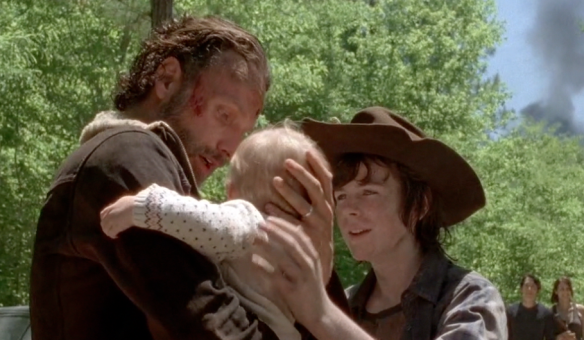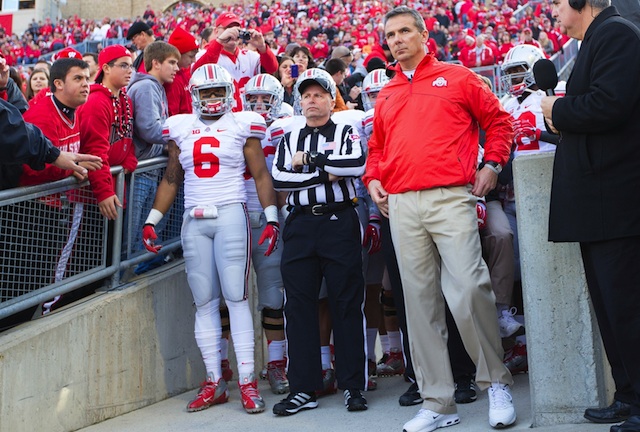After thinking a lot about the plight of Carl and the other children on The Walking Dead, I decided that I had a lot more to say on the subject than I originally anticipated. So, welcome to part two, which takes us all the way back to the very beginning of the show.
The first scene of The Walking Dead in the first season, first ever episode (“Days Gone Bye”) finds the viewer watching Rick Grimes approach an abandoned gas station. The scene is dismal. There are wrecked cars everywhere, others simply left where they are. The place is extremely quiet. Rick finally sees movement when he ducks under a car and spots small, moving legs. There, he sees what appears to be a small child, wearing a robe and slippers. She picks up a teddy bear and continues moving. He calls out to her, and she turns around, revealing part of her right cheek missing, sunken eyes, and a general disheveled appearance that comes with being turned into the undead. This zombie child starts for Rick, eventually forcing him to fire his gun, shooting her through the head and killing her for the final time.
The reason this scene works so well is that it shows precisely what is at stake and what this show is all about. The writers could have picked pretty much anyone for Rick to encounter as a zombie in the first scene of what will eventually become a crazy-popular show, but they choose to force Rick to kill a small child. It is powerful because it shows the cruelty of what the world has become and gives us as viewers a small glimpse into what Rick must do to survive. But it also tells us that this show is alluding to Rick’s later infanticidal actions.
To me, this scene sets up the show and its messages very well. It shows us that children are central to this show, and that their deaths mean something. In this case, the little girl’s death means that the rules Rick once followed no longer apply; the old world has no more bearing on what he must do now. And, as I mentioned, it means that the whole world is infanticidal. It is a rule that this show must live by. Any time an act is infanticidal, the show is reminding you of the previous lesson that it wants you to learn: that we must take care to treat our children well.
Don’t believe me? Let’s look again at Lori’s pregnancy.
The thing about a pregnancy is that it is both a conception and a contraception at once. What I mean by that is this: while the act of being pregnant means that you’re indeed bringing a life into this world, you’re also destroying the possibility of an infinite amount of other lives being brought into this world.
So while a pregnancy seems productive, it really is more destructive in its nature. A simple way to put it is this: where there is life, so too is there death. This may not seem like such a big revelation, but the world of The Walking Dead seems so much different from our own. What the show is trying to tell us is that it’s really not all that different from the world we’re used to. People get pregnant in the real world, and people in the show-world also get pregnant. The same rules apply regardless of where you are.
In the case of Lori, she must die so that the baby survives. So far, the Grimes children are the luckiest children in the show. While the rules still apply to them, they are able to avoid death with the help and selflessness (and in some cases selfishness) of others. Judith survives because her mother was willing to die. Carl survives his gunshot wound because Shane Walsh is willing to kill Hershel Greene’s man Otis in order to get back to the farm alive. However, things are not so for the other children of The Walking Dead.
The first real child Rick encounters is Duane, the son of Morgan Jones—the man who saves Rick’s life right after he wakes up. Duane seems like your average 13 or 14-year-old. His father even encourages him to continue reading his comic books. Morgan is responsible for keeping his son safe, especially since the boy’s mother (Jenny) has turned into a Walker. Morgan corrects Duane’s grammar, reminds him to say his “please”s and “thank you”s, and comforts the boy when he is upset by his zombie-mother approaching the house they’re staying in. Overall, Morgan seems the epitome of a “good” father figure to his son.
Eventually, we learn in season three, episode 12, “Clear”—one of my favorite episodes—that Duane has been turned into a Walker by his own mother. As we know, Morgan and Rick had a few conversations about Jenny as a Walker during the first episode.
Rick had urged Morgan to kill his wife, as it would be the only way he could move on. The guilt Morgan must have experienced during the aftermath of his son being turned was tremendous. While the act of a mother killing her son is heinous, even when the mother is now a zombie and doesn’t know what she’s doing, Morgan was finally able to kill his wife. Though it is unclear what he did to Duane, I’m going to assume he killed his son as well. Because of this, Morgan goes mad from regret and guilt at not having been strong enough to kill his wife in the first place as Rick suggested.
The death of Duane shows us that the world is most cruel to those we would consider the most innocent. This theme gets repeated countless times.
The next children we as viewers encounter are Carl Grimes, Sophia Peletier (Carol’s daughter), and Eliza and Louis Morales. Carl was discussed extensively in my original post, so I will skip him for now. The Morales children left with their parents and their whereabouts are unknown. This leaves Sophia Peletier. Sophia is 12 years old and is made to be extremely child-like despite her age and the situation she finds herself in. Generally, she is seen holding onto a doll that Eliza Morales gave to her as a parting gift when her family and the rest of the group parted ways. She holds onto this doll for security, and this, as a result, helps in her infantilization. Her mother worries over her, particularly because she believes her husband, Ed, to be abusive to Sophia physically, psychologically, and sexually, just as Ed is towards Carol. Sophia does not get many speaking lines. Generally, viewers see her crying, following her mother or Carl, playing with her doll, holding onto her doll, or being silent, furthering infantilizing her.
When the group is stranded on the highway and must hide from the herd of Walkers, Sophia is underneath a car when she emerges too soon. A Walker spots her and begins to give chase. Sophia runs into the woods, now two Walkers following her, and Rick goes after Sophia. As we all know, Sophia becomes lost. Eventually, once the group is on the farm and has nearly given up looking for her, they find Sophia with the other Walkers Hershel keeps in the barn. In a scene that is uncannily like the first scene of the first season, Rick shoots Sophia to kill her, as she is now a zombie.
The fact that the writers, producers, and directors spend so much time infantilizing Sophia—to the point that she is all but voiceless or screaming as an infant does (and, if we recall, that is the one thing Carol later tells us about Sophia as an infant: that she cried like clockwork every night at three in the morning)—has to mean something. To me, this shows how innocent Sophia is. In fact, the parents so far seem to be very good and protective by many viewers’ standards. They are protecting their children from the world they now live in and are attempting to treat their children as they would have before. But, as we can see, this treatment is getting them killed.
This leads me to how Rick’s group ends up on Hershel Greene’s farm in the first place. While looking for Sophia, Rick, Shane, and Carl encounter a deer. In a moment of serenity, Rick allows Carl to approach the deer instead of killing it for dinner as soon as it comes into their line of sight. The image presented is a beautiful one. The deer is still, silent, and complacent with Carl’s approach. Carl’s face is lit up with happiness as he approaches the deer. Everything happens in slow motion. And then we hear the gunshot. Carl drops. Everything returns to normal speed, and the last image of the season is Rick screaming for his son.
We as viewers are given another image of innocence, of childhood, and it is taken away from us with a violence that is sudden, gruesome, and nearly deadly.
The next child I wish to discuss is Penny Blake, the Governor’s daughter. When viewers first see her, we don’t know she’s a Walker. What we do see is a serene scene of a father taking care of his daughter, brushing her hair. That’s when we realize the Governor is keeping his zombie-daughter captive. Despite her state, the Governor is extremely loving toward his daughter and seems insistent on both keeping her alive and carrying on their relationship as normally as he possibly can. While it may seem sweet at first, if we are to think about this scene and the other the Governor has with Penny, we realize this is a perverse relationship. If the Governor still views Penny as his daughter, regardless of her condition, the way that he keeps her (tied up in a strait jacket, chained, with a bag over her head, and locked up in a dark room) is abhorrent.
Michonne returns to Woodbury to kill the Governor, but instead finds Penny. She is fooled by Penny when she first encounters the girl, thinking that the Governor has kept an alive child chained in a dark room. In an uncharacteristic move thus far, Michonne immediately begins to comfort the girl in a soothing way. For an instant, Michonne has become a surrogate mother, willing to help the child and protect her. That changes in yet another instant, when Michonne realizes that the girl is already dead. We receive yet another image of a mother figure killing a child, however this child has been forever changed by this world and cannot be allowed to live.
But why is this? Let’s take a look at the title where we first see baby Judith. It’s called “The Killer Within.” Not such a nice nickname to give to a child, even if it’s true. However, are we for certain what “The Killer Within” really is? It could refer to any child in a womb. It could also refer to the disease (or whatever it is) that makes everyone change into a zombie once they die. It could even refer to the female body “killing” the other opportunities for pregnancy once the body is already pregnant.
The fact that the cliffhanger for the mid-season finale in the fourth year is Judith’s carrier being empty and covered in blood resonates with everyone. She was sort of this symbol of hope, and rightly so. The Book of Judith in The Bible shows Judith as a woman of action. She kills the leader of invading foreigners, forcing the rest to disperse and saving her fellow countrymen from extinction. Judith has a lot to live up to with a name like that.
Will her fate be the same as the other children’s in The Walking Dead? Or will she and her brother continue to defy those odds? If we follow the rules, for every life there must be a death, Judith’s outlook seems very grim, even after all that happens in season four and five.


